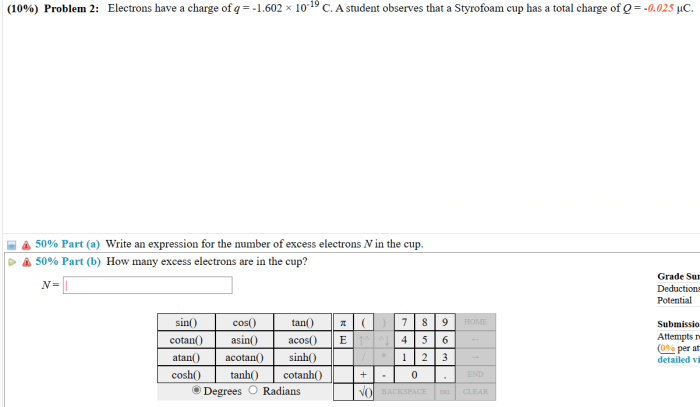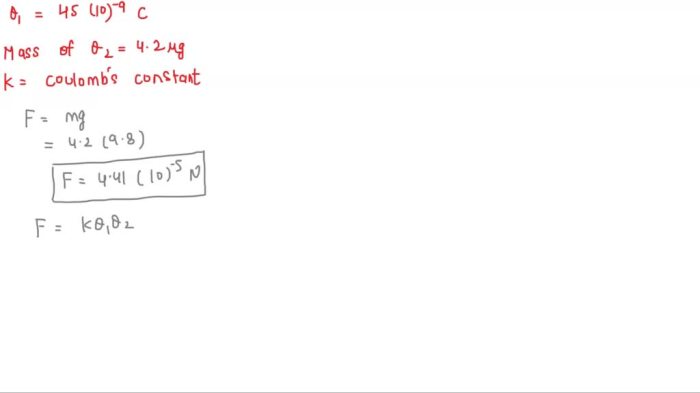Calculate the magnitude of q2 in units of nanocoulombs – Calculating the magnitude of Q2 in units of nanocoulombs is a fundamental aspect of understanding electric charge and its behavior. This guide delves into the concept of electric charge, its units, and the methods used to calculate the magnitude of Q2 in nanocoulombs.
It also explores the practical applications and factors affecting the magnitude of Q2, providing a comprehensive overview for readers.
Magnitude of Q2

Electric charge is a fundamental property of matter that determines its interaction with electric and magnetic fields. The magnitude of an electric charge represents the amount of charge it carries and is measured in units called coulombs (C). However, in many practical applications, it is convenient to use smaller units, such as nanocoulombs (nC), which are equal to one billionth of a coulomb (1 nC = 10 -9C).
Calculating the magnitude of an electric charge involves determining the amount of charge present in a given system. This can be achieved through various methods, such as measuring the current flowing through a circuit, using a capacitor to store charge, or employing specialized instruments like electrometers.
Calculating Magnitude of Q2
To calculate the magnitude of Q2 in units of nanocoulombs, the following steps can be taken:
- Measure the current (I) flowing through a circuit for a known period of time (t).
- Calculate the charge (Q) transferred during that time using the formula Q = I
t.
- Convert the charge Q to nanocoulombs by multiplying it by 10 9.
For example, if a current of 2 milliamperes (mA) flows through a circuit for 5 seconds, the charge transferred is:
Q = I – t = (2 mA) – (5 s) = 10 mC
Converting this to nanocoulombs:
Q2 = Q – 10 9= (10 mC) – (10 9) = 10 10nC
Applications of Q2 Magnitude Calculation, Calculate the magnitude of q2 in units of nanocoulombs
Calculating the magnitude of Q2 in nanocoulombs has numerous practical applications in various fields, including:
- Electronics:Determining the charge stored on capacitors in electronic circuits, which is crucial for designing and analyzing circuits.
- Physics:Measuring the charge of subatomic particles, such as electrons and protons, in particle accelerators and detectors.
- Engineering:Calculating the charge accumulation on materials in electrostatic discharge (ESD) scenarios, which is important for preventing damage to sensitive electronic components.
Understanding the magnitude of Q2 allows engineers and scientists to design and optimize systems that rely on electric charge, ensuring their efficient and safe operation.
Factors Affecting Q2 Magnitude
The magnitude of Q2 can be influenced by several factors, including:
- Voltage (V):The potential difference between two points in a circuit determines the amount of charge that can flow. A higher voltage leads to a greater magnitude of Q2.
- Capacitance (C):The ability of a capacitor to store charge is directly proportional to its capacitance. A larger capacitance results in a higher magnitude of Q2 for a given voltage.
- Material properties:The electrical properties of the material, such as its conductivity and permittivity, can affect the magnitude of Q2 stored or transferred.
By understanding these factors, it is possible to control and manipulate the magnitude of Q2 in practical applications, optimizing the performance and functionality of electronic devices and systems.
Q&A: Calculate The Magnitude Of Q2 In Units Of Nanocoulombs
What is the significance of calculating the magnitude of Q2?
Calculating the magnitude of Q2 provides insights into the behavior of charged particles and their interactions within electric fields.
How does the magnitude of Q2 affect the behavior of charged particles?
The magnitude of Q2 influences the strength of the electric force experienced by charged particles, determining their acceleration and trajectory.


